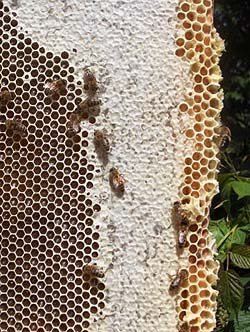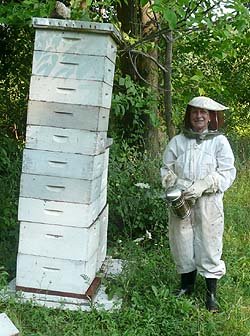to everything there is a season
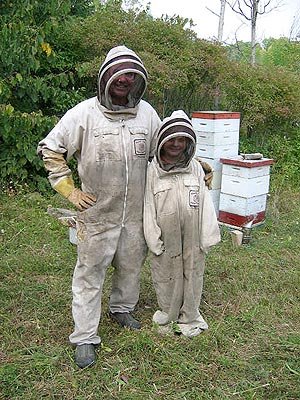
Vermont, after the harvest, fall 2007
For a long time I have been curious about the bees. I was struck by their beauty and the way they worked so harmoniously and efficiently together. The great thing about being a filmmaker is that when you get interested in something, and want to learn more about it, you can make a film. I started filming in the spring of 2006 and am nearly finished. In the process of doing the film I have gotten four beehives of my own.
In getting to know the bees I have found that I have an emotional feeling for them, which surprised me. I hadn’t imagined that you could feel for an insect as you might a cat or dog. I really love the little creatures.
The bees have also helped me get closer to nature. I am always wondering how the heat or cold, or rain or dryness is affecting them. I am more aware of what is flowering and where the bees are going. I love to sit at the hive and watch the bees landing with their pollen filled baskets. I love their little navigational dances at the hive entrances, where they guide their sister bees to nectar and pollen sources. I have also observed that since getting bees we have gotten more green beans than ever before. We also saw a lot of bees on the raspberry flowers and had a great crop. The apple trees in the orchard across the street from our house are loaded with fruit. The trees were roaring with bees when they were in flower this spring. I don’t know if these increased yields are a consequence of the bees or just good weather conditions this summer but I am keeping my eye on it.
I have also learned a lot about the health benefits of bees and in addition to raw honey, pollen and propolis I have really benefited from bee stings! When I started my film I had tendonitis in my elbow and a sore shoulder. Since having been stung numerous times, on purpose or not, I am pain free.
My introduction to the bees has been rich beyond expectation and I thank Honey Gardens for their guidance along this path. I hope that through my film you too may feel some of what I have experienced.
Jan is interested in recording the voices of sustainable living. He observes that many people still do not understand that our earth’s resources are limited and that our over-consumption has seriously negative consequences.
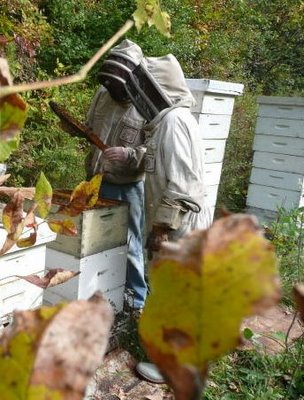
Native pollinators
I took this picture at about 4:00 p.m. on a rather cool day. The honey bees had gone home. Our native pollinator, the bumblebee, flies in cooler temperatures, so these two were still working the asters in the farm fields behind my house. from Nectar and Pollen Plants of the Champlain Valley, Vermont: A Field Report by Annie Watson

Fresh pollen is a source of energy and nutrition. Because of its tough shell, only 30% of the value may be utilized if pollen is eaten straight out of the bag. If you let it sit for 10 minutes in your oatmeal, orange juice, smoothie or other liquid, a much greater value may be gained.
We thank you for your support of the bees, plants and those who work in agriculture.
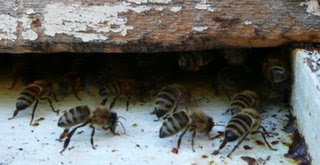 as to evaporate the water from the nectar to help turn it into honey. It is amazing to see how these tiny creatures brace themselves on their legs in a hunched-over position, remaining in position as they are jostled by other workers and drones coming and going, and even by would-be invaders such as yellow jackets and bumblebees. Single-minded in their devotion to their task, they leave it to the guard bees to chase away potential robbers.
as to evaporate the water from the nectar to help turn it into honey. It is amazing to see how these tiny creatures brace themselves on their legs in a hunched-over position, remaining in position as they are jostled by other workers and drones coming and going, and even by would-be invaders such as yellow jackets and bumblebees. Single-minded in their devotion to their task, they leave it to the guard bees to chase away potential robbers. honey Thistle Hill’s colonies are making from 3o feet away, it has been so strong the last few days.
honey Thistle Hill’s colonies are making from 3o feet away, it has been so strong the last few days.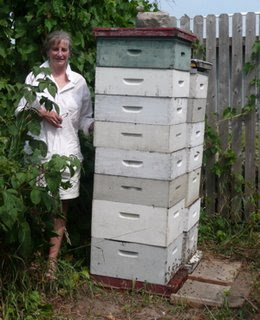 Annie Watson, creator of this blog, with her two colonies of honey bees and crop
Annie Watson, creator of this blog, with her two colonies of honey bees and crop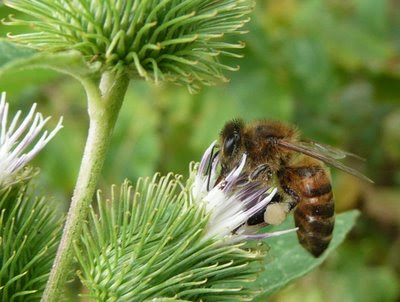 bees gathering nectar and pollen from the burdock flowers in the past 7 days. With the land so dry, the flowers are not producing as much nectar. The more flowers we leave growing, the more food the bees can make for their winter.
bees gathering nectar and pollen from the burdock flowers in the past 7 days. With the land so dry, the flowers are not producing as much nectar. The more flowers we leave growing, the more food the bees can make for their winter.